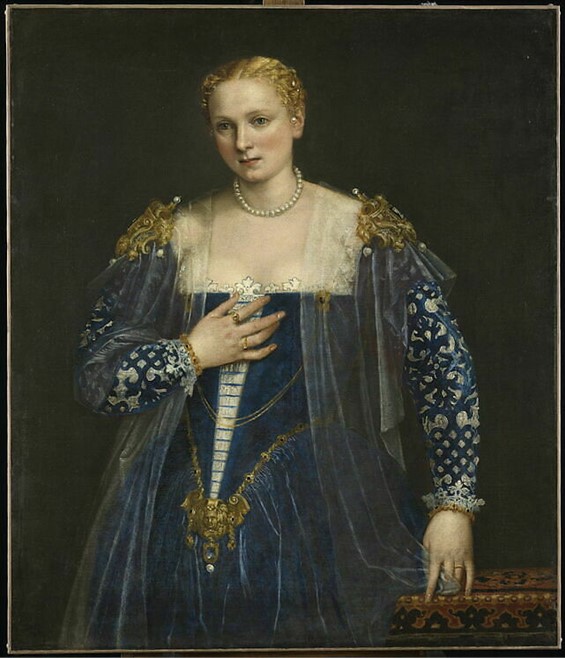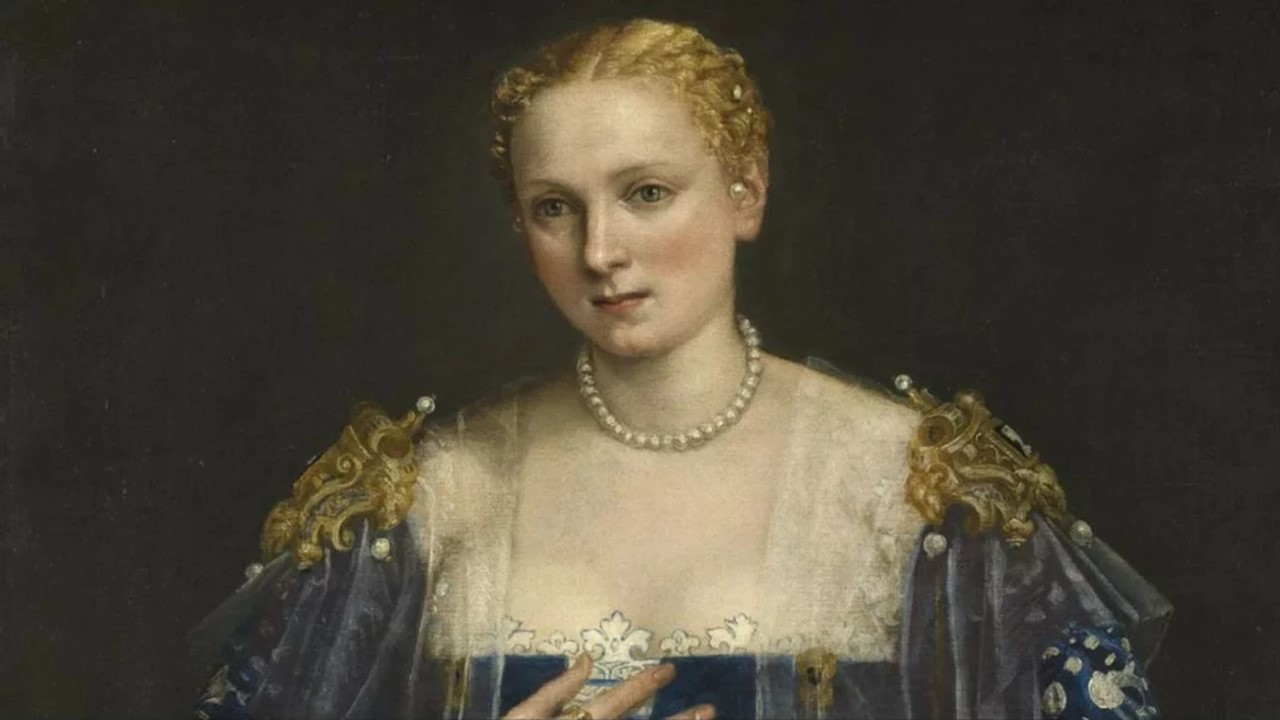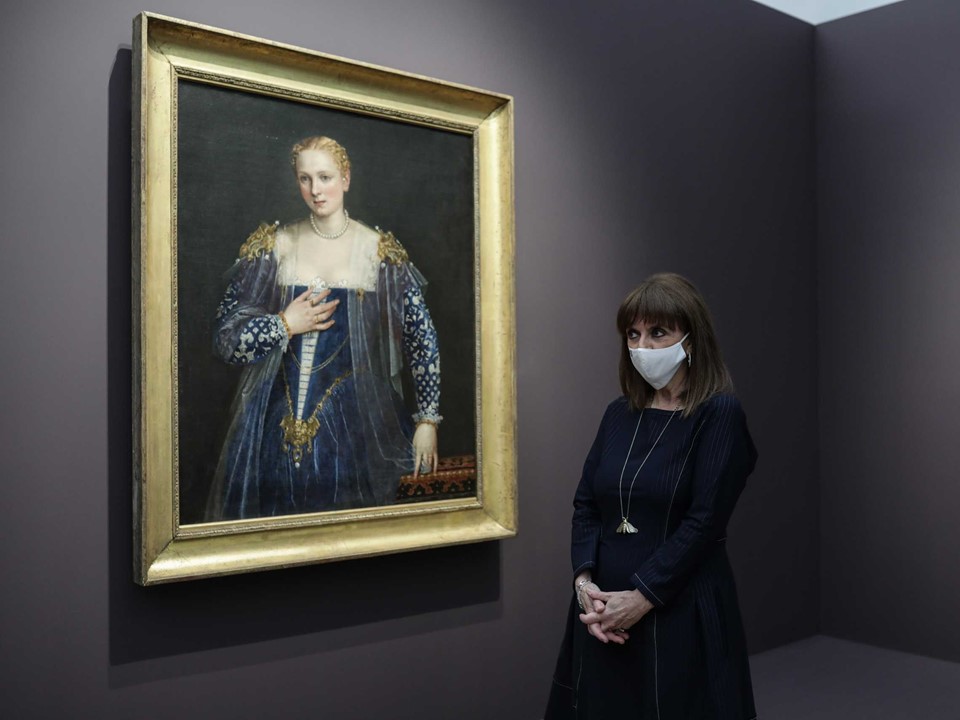
Portrait of a Venetian Woman – La Belle Nani, circa 1560, oil on canvas, 119×103 cm, Louvre Museum, Paris, France
https://collections.louvre.fr/en/ark:/53355/cl010065927
Men were created before women… But that doesn’t prove their superiority – rather, it proves ours, for they were born out of the lifeless earth in order that we could be born out of living flesh. And what’s so important about this priority in creation, anyway? When we are building, we lay foundations on the ground first, things of no intrinsic merit or beauty, before subsequently raising up sumptuous buildings and ornate palaces. Lowly seeds are nourished in the earth, and then later the ravishing blooms appear; lovely roses blossom forth and scented narcissi… writes Moderata Fonte in her book The Worth of Women: Wherein Is Clearly Revealed Their Nobility and Their Superiority to Men, and I think that La Belle Nani by Paolo Veronese is one such Venetian… ravishing bloom, a lovely roses blossom, a scented narcissi! https://www.goodreads.com/author/quotes/893320.Moderata_Fonte and https://books.google.gr/books?id=AtTGAAAAQBAJ&pg=PA138&lpg=PA138&dq=Men+were+created+before+women.+…+But+that+doesn%27t+prove+their+superiority+%E2%80%93+rather,+it+proves+ours,+for+they+were+born+out+of+the+lifeless+earth+in+order+that+we+could+be+born+out+of+living+flesh.+And+what%27s+so+important+about+this+priority+in+creation,+anyway?+When+we+are+building,+we+lay+foundations+on+the+ground+first,+things+of+no+intrinsic+merit+or+beauty,+before+subsequently+raising+up+sumptuous+buildings+and+ornate+palaces.+Lowly+seeds+are+nourished+in+the+earth,+and+then+later+the+ravishing+blooms+appear;+lovely+roses+blossom+forth+and+scented+narcissi.&source=bl&ots=LzBLZk1PqE&sig=ACfU3U14hiEGCMR-a1Zp9IywMToXnxIAsw&hl=el&sa=X&ved=2ahUKEwi37YHOwKb1AhXLgv0HHYiYA1AQ6AF6BAgCEAM#v=onepage&q&f=false
What an incredible portrait La belle Nani is! Created by Paolo Veronese (1528-1588), one of the most famous painters of the Cinquecento, it fascinates and fires the imagination. Who is she? Is she a respectable Venetian matron, one of Venice’s famous courtesans, or is she the image of the Venetian ideal beauty? Well, we do not really know… except that back in the 19th century, it was thought that the portrait was commissioned by the Nani, a patrician family of Venice, and thus, the nickname La Belle Nani was adopted. http://editions.louvre.fr/en/titles/monographs/painting/veroneseune-dame-venitienne-dite-la-belle-nani.html

Portrait of a Venetian Woman – La Belle Nani (detail), circa 1560, oil on canvas, 119×103 cm, Louvre Museum, Paris, France
https://www.iefimerida.gr/politismos/ethniki-pinakothiki-loybro-maska-napoleonta-parisi
The portrait of the “Beautiful Nani” follows, according to the Louvre experts, a very fashionable compositional formula developed by no other than the greatest portrait painter of the Venetian Renaissance, Titian. The model is depicted facing the viewer, in front of a dark neutral background, and is placed next to an element of furniture, in Veronese’s painting, a table covered with a precious carpet of Anatolian manufacture, known as “a la Moretto” style. Portrayed against a sober background the beautiful woman bursts of light and colour reflecting the extraordinary skills of the Venetian Renaissance artist. https://collections.louvre.fr/en/ark:/53355/cl010065927
The Louvre Portrait exalts the beauty of a young woman as much as the richness of her dress. It is believed that this is the Portrait of an aristocratic Venetian mother… beautiful and utterly fashionable! Her delicate complexion, for example, is white and pink, indicating that the lady is protecting herself from the sun. Her sparkling hair is blond, a color that was obtained, according to the beauty recipes of the time, by exposing hair to the midday sun, on the roofs of Venetian palaces. Her ceremonial dress, made of luxurious blue velvet and branched brocade on a white background, is fashionably loose, with a fairly wide opening on the chest, a light white gauze coat draped over her shoulders, and sumptuous pieces of jewelry all over her. https://collections.louvre.fr/en/ark:/53355/cl010065927
La belle Nani is beautiful, fashionable, and virtuous… She chastely turns her gaze away from that of the spectator. Her left hand, whose ring finger is adorned with a wedding ring, elegantly re-dyes the transparent veil of her coat, while her right hand rests on her heart, as a sign of conjugal fidelity. The portrait must thus signify the exemplary nature of this woman: her high social rank, her physical beauty, and her moral virtue. https://collections.louvre.fr/en/ark:/53355/cl010065927

https://www.newsit.gr/politikh/katerina-sakellaropoulou-egkainiase-ekthesi-tis-ethnikis-pinakothikis-foros-timis-sto-mouseiou-tou-louvrou/3418282/
In Search of Immortality – The Art of Portrait in the Louvre Collections (December 1, 2021-28 March 2022) is a wonderful Exhibition at the National Gallery in Athens, Greece. La Belle Nani is just one of one hundred portraits from the Louvre Museum Exhibited in Athens. An impressive selection of valuable works of art dating from the period of Pharaonic Egypt to Gericault and Delacroix, the Athens Exhibition explores the genre of Portraiture with stunning examples like… The Death of Mara by Jacques-Louis or Bonaparte at the Pont d’Arcole by Antoine-Jean Gros. This is an Exhibition worth visiting! https://digitalculture.gov.gr/2021/11/ethniki-pinakothiki-anazitontas-tin-athanasia-i-techni-tou-portretou-stis-silloges-tou-louvrou/
For a PowerPoint on Portraits of Renaissance Women by Paolo Veronese, please… Check HERE!